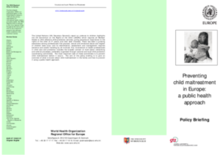The UN Secretary General’s report on violence to children highlights the UN Convention on the Rights of the Child (UNCRC) which requires all member states to offer effective child protection services, giving paramount importance to the rights of the child (0-17 years) and their best interests. There has been a growing awareness among professionals that physical, sexual and emotional abuse and neglect of children does occur and its identification, assessment and management requires sensitive and careful handling by all involved.
The aim of this policy briefing is to give an overview of what is known about child maltreatment in the family and how to prevent it using a public health approach. This approach moves the focus away from child protection teams intervening after child maltreatment has occurred; instead it highlights the role of the health and social services in primary prevention and in targeting services to children and families most in need of help and support before violence occurs.
This document presents strategies for primary, secondary, and tertiary prevention of child maltreatment, as part of this wider public health approach. It further underscores the importance of an appropriate ecological framework (with interventions at societal, community, relationship, and individual levels) to achieving the maximal effect of preventive efforts.
This policy brief was followed by a short supporting document: The Cycles of Violence: The Relationship Between Childhood Maltreatment and the Risk of Later Becoming a Victim or Perpetrator of Violence: Key Facts.
©Violence and Injury Prevention Programme (WHO Regional Office for Europe)

